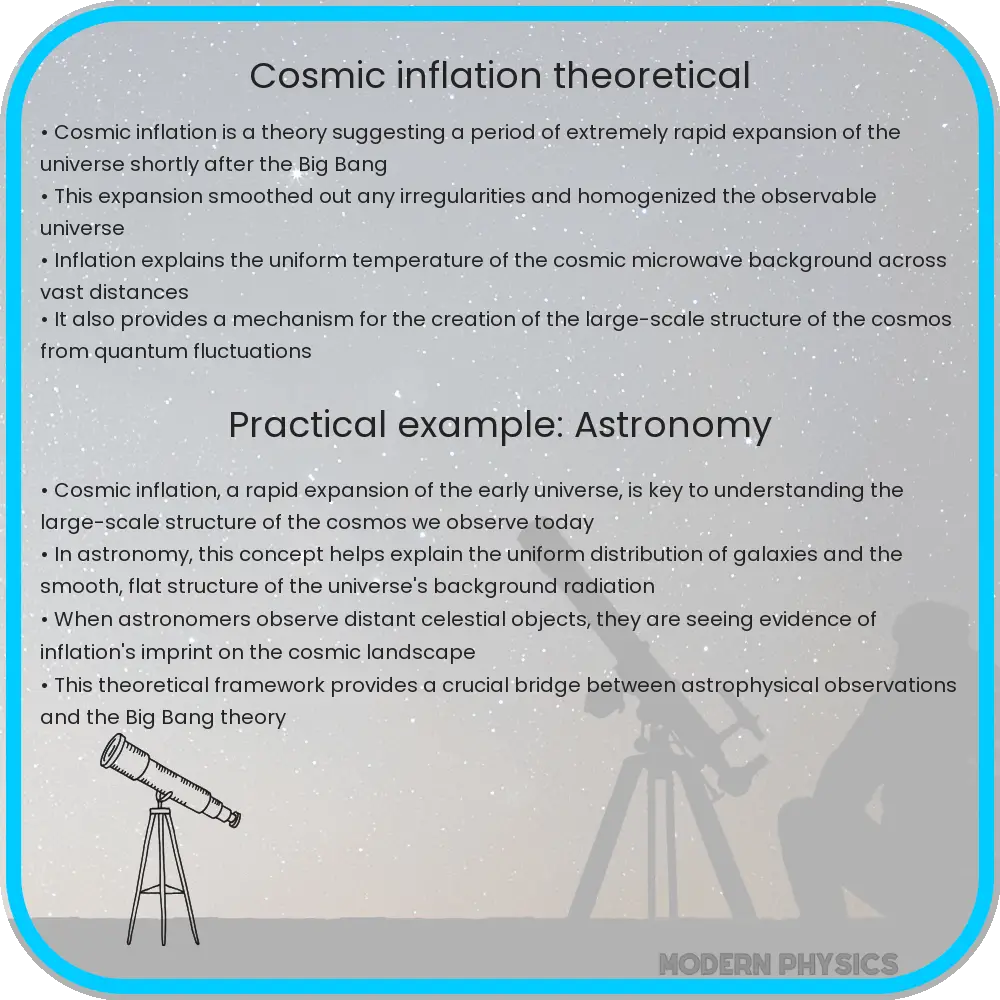Explore Cosmic Inflation: Understand its origins, theory, relation to relativity, and how it shapes our understanding of the universe’s birth.

Understanding Cosmic Inflation: The Dawn of the Universe
The concept of Cosmic Inflation is a monumental idea in modern cosmology, revolutionizing our understanding of the universe’s birth and evolution. Proposed by physicist Alan Guth in 1981, this theory provides a framework for explaining the rapid expansion of the universe immediately following the Big Bang.
The Origins of Cosmic Inflation
In the 1970s, the Big Bang theory faced significant challenges, particularly the horizon problem and the flatness problem. The horizon problem arises from the uniform temperature of the Cosmic Microwave Background (CMB) across vast distances, seemingly impossible without some form of faster-than-light communication. The flatness problem concerns the universe’s density being finely tuned to support a flat geometry. Cosmic Inflation emerged as a compelling solution to these puzzles.
Theory of Cosmic Inflation
Cosmic Inflation postulates that, during the first 10-36 seconds after the Big Bang, the universe underwent an exponential expansion, increasing in size by a factor of at least 1026. This rapid expansion smoothed out any irregularities and homogenized the universe, explaining the uniformity of the CMB. Additionally, it drove the universe’s density towards the critical density, solving the flatness problem.
At the heart of this theory is a hypothetical particle or field, known as the inflaton. The inflaton is thought to have caused this exponential expansion due to its unique energy properties, which dominated the early universe. After this brief period, the inflaton decayed, reheating the universe and setting the stage for the formation of particles and, eventually, the structures we observe today.
Cosmic Inflation and General Relativity
General Relativity, formulated by Albert Einstein, is crucial in understanding Cosmic Inflation. Inflation theory relies on General Relativity’s framework, which describes how matter and energy shape the fabric of spacetime. Inflation extends this by introducing a scalar field that temporarily alters the dynamics of spacetime, causing the rapid expansion. This interplay between inflation and relativity is fundamental in explaining the early universe’s evolution.
In summary, Cosmic Inflation offers a compelling explanation for some of the biggest mysteries of the universe’s early moments. By addressing the horizon and flatness problems, it sets a solid foundation for understanding the universe’s birth and its first fleeting moments.
Implications and Evidence for Cosmic Inflation
Cosmic Inflation is not just a theoretical concept; it has empirical implications. One of the most significant pieces of evidence supporting inflation is the anisotropy observed in the Cosmic Microwave Background (CMB). The CMB, a relic radiation from the early universe, exhibits tiny fluctuations in temperature. These fluctuations, mapped extensively by missions like the COBE, WMAP, and Planck satellites, align remarkably well with the predictions of inflationary models. They indicate the presence of density variations in the early universe, which eventually led to the formation of galaxies and large-scale structures.
Another key piece of evidence is the observed large-scale structure of the universe. The distribution of galaxies and galaxy clusters on cosmic scales is consistent with the quantum fluctuations that were stretched to astronomical scales during inflation. This stretching explains the uniformity and structure of the universe we observe today.
Challenges and Future Research
Despite its successes, Cosmic Inflation is not without its challenges. One significant issue is the initial conditions problem, questioning what preceded inflation and why it started. Furthermore, the exact nature of the inflaton field remains elusive, with no direct detection of the particle or field responsible for inflation.
Future research in cosmic inflation involves both theoretical and observational approaches. Theoretical work aims to integrate inflation with quantum mechanics and string theory, potentially leading to a more unified understanding of physics. Observationally, researchers are seeking more precise measurements of the CMB and gravitational waves, which could offer insights into the inflationary epoch.
Conclusion: The Legacy and Future of Cosmic Inflation
Cosmic Inflation stands as one of the most profound ideas in cosmology, offering a window into the universe’s earliest moments. By solving the horizon and flatness problems, it provides a coherent and testable framework for understanding the Big Bang and the universe’s subsequent evolution. The evidence from the CMB and large-scale structure supports this theory, yet questions remain, fueling ongoing research and debate.
The future of cosmic inflation research is rich with potential. Advances in observational technology and theoretical physics promise to deepen our understanding of the universe’s infancy. As we continue to probe the cosmos, the principles of cosmic inflation will undoubtedly play a crucial role in unraveling the mysteries of the universe’s origin and evolution.
